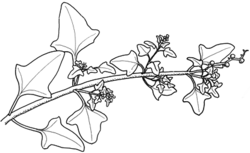Common name: Climbing Saltbush
Einadia nutans (R.Br.) A.J.Scott APNI* 
Description: Perennial rootstock with prostrate or twining herbaceous or woody stems.
Leaves alternate or opposite, linear, lanceolate or narrow-sagittate, to 30 mm long, glabrous; petiolate.
Inflorescences few-flowered, axillary and terminal, spike-like, bisexual; stamens 2 or 3.
Fruit with an inflated succulent pericarp, red or yellow.
Distribution and occurrence: Heavy soils over much of the southern half of the continent, in and around other shrubs or trees.
NSW subdivisions: NC, CC, SC, NT, CT, ST, NWS, CWS, SWS, NWP, SWP, NFWP, SFWP
Other Australian states: Qld Vic. Tas. N.T. S.A. W.A.
Text by S. W. L. Jacobs
Taxon concept:
| | Key to the subspecies | |
| 1 | At least some leaves narrow-sagittate, sagittate or hastate | 2 |
| Leaves linear | subsp. linifolia |
| 2 | Inflorescence with sterile spine-like branches; fruit ovoid, apex acute; mature perianth and leaves with scattered vesicular hairs | subsp. oxycarpa |
| Inflorescence only rarely with sterile spine-like branches; fruit subglobose; mature perianth and leaves usually without vesicular hairs
Back to 1 | 3 |
| 3 | Some leaves 20–30 mm long; stems robust and striate | subsp. eremaea |
| Leaves usually <20 mm long; stems less robust
Back to 2 | subsp. nutans |
APNI* Provides a link to the Australian Plant Name Index (hosted by the Australian National Botanic Gardens) for comprehensive bibliographic data
***The AVH map option provides a detailed interactive Australia wide distribution map drawn from collections held by all major Australian herbaria participating in the Australian Virtual Herbarium project.
|


